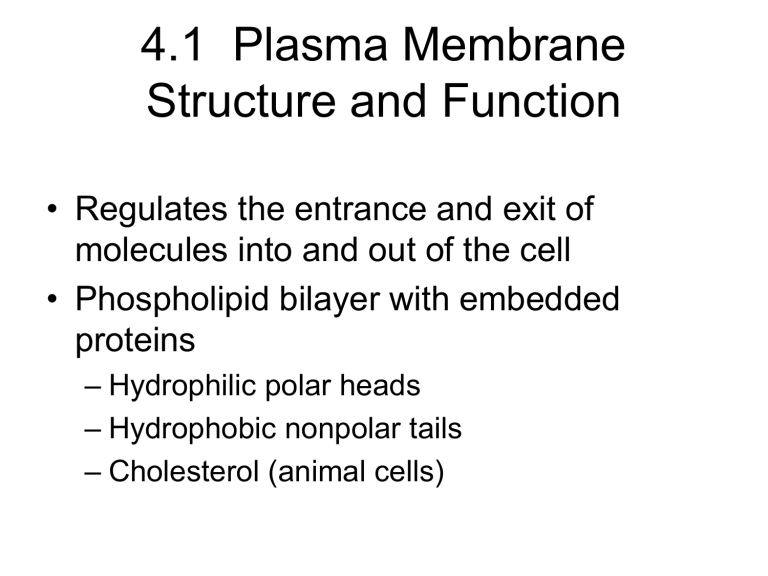4.1 Plasma Membrane Structure and Function

4.1 Plasma Membrane
Structure and Function
• Regulates the entrance and exit of molecules into and out of the cell
• Phospholipid bilayer with embedded proteins
– Hydrophilic polar heads
– Hydrophobic nonpolar tails
– Cholesterol (animal cells)
Fluid-mosaic Model of Plasma
Membrane Structure
4.1 Plasma Membrane
Structure and Function
• Types of Membrane Proteins
– Channel Proteins
– Carrier Proteins
– Cell Recognition Proteins
– Receptor Proteins
– Enzymatic
A Proteins
4.2 Permeability of the Plasma
Membrane
• Differentially (selectively) Permeable
• Factors that determine how a substance may be transported across a plasma membrane:
– Size
– Polar or Nonpolar
How Molecules Cross the
Plasma Membrane
Passage of Molecules into and out of the Cell
Know for test
4.2 Permeability of the Plasma
Membrane
• Diffusion and Osmosis
– Diffusion is the movement of molecules from an area of higher to lower concentration
Process of Diffusion
4.2 Permeability of the Plasma
Membrane
• Diffusion and Osmosis
– Diffusion is the movement of molecules from an area of higher to lower concentration
– Oxygen and Carbon Dioxide are two gases that can diffuse through the plasma membrane
Gas Exchange in Lungs
4.2 Permeability of the Plasma
Membrane
• Osmosis
– Osmosis is the diffusion of water across a differentially permeable membrane.
4.2 Permeability of the Plasma
Membrane
• Osmosis
– Osmosis is the diffusion of water across a differentially permeable membrane.
– Osmotic pressure is the pressure that develops in a system due to osmosis.
Osmosis Demonstration
4.2 Permeability of the Plasma
Membrane
• Osmosis
– Isotonic: the solute concentration is equal inside and outside of a cell
– Hypotonic: a solution has a lower solute concentration than the inside of a cell
– Hypertonic: a solution has a higher solute concentration than the inside of a cell
Osmosis in Animal and Plant Cells
4.2 Permeability of the Plasma
Membrane
• Transport by Carrier Proteins
– Carrier proteins combine with a molecule or ion to be transported across the membrane.
– Carrier proteins are required for:
• Facilitated Transport
• Active Transport
Facilitated Transport
• Small molecules that are not lipid-soluble
• Molecules combine with carrier proteins
• Molecules follow the concentration gradient
• Energy is not required
4.2 Permeability of the Plasma
Membrane
• Active Transport
– Small molecules
– Molecules combine with carrier proteins
– Molecules move against the concentration gradient
– Energy is required
The Sodium-Potassium Pump
4.2 Permeability of the Plasma
Membrane
• Vesicle Formation
– Transport of large molecules
– Requires energy
– Keeps the macromolecule contained
4.2 Permeability of the Plasma
Membrane
• Vesicle Formation
– Exocytosis - Vesicles form as a way to transport molecules out of a cell
Exocytosis
Vesicle Formation
• Vesicle Formation
– Endocytosis - Vesicles form as a way to transport molecules into a cell
• Phagocytosis: Large,particulate matter
• Pinocytosis: Liquids and small particles dissolved in liquid
• Receptor Mediated Endocytosis : A type of pinocytosis that involves a coated pit
Three Methods of Endocytosis

